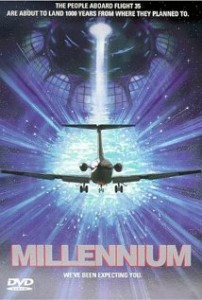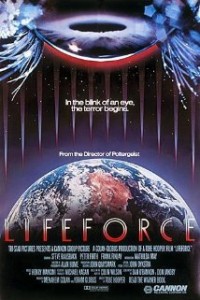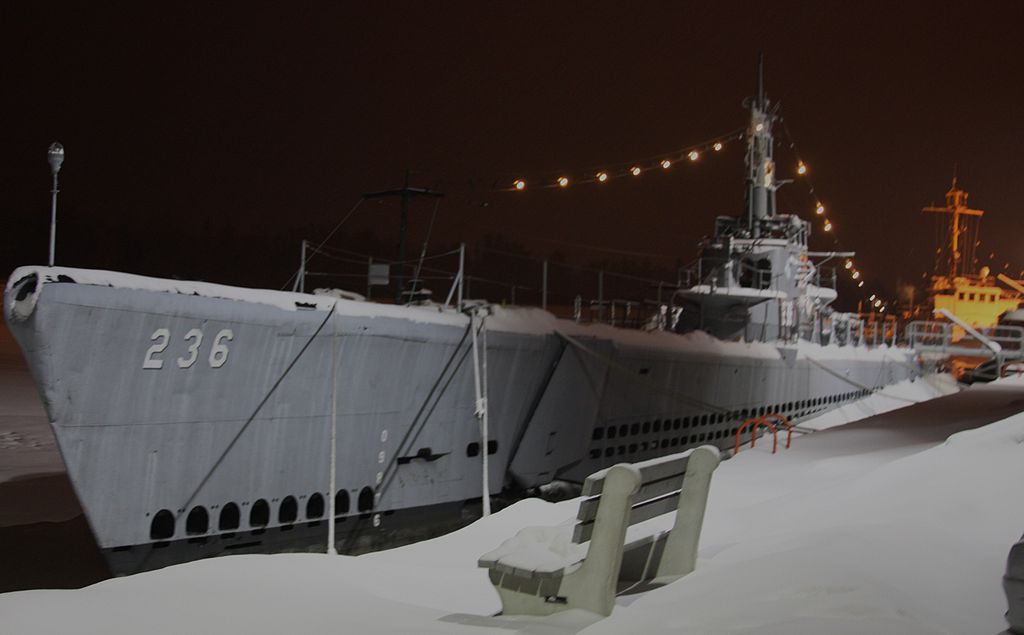Early on in the Avengers there’s a sequence where the Black Widow (Scarlett Johansson) is interrogating some Russian mobsters. The scene is set in Russia. It opens with a freight train speeding past a warehouse. The freight train’s locomotive is painted in a black scheme with white stripes and markings. If you know your trains it’s very clearly a Norfolk Southern locomotive. NS engines aren’t found in Russia, but they’re found in Cleveland, where the scene was shot. Every time I watch that scene I think the interrogation is taking place in the United States, not Russia, because of that contextual hint.
Suspension of disbelief is a funny thing. I have no problem with the Asgardians, or Helicarriers, or any of that other stuff. That’s all fantastical and it’s fine. An American train in Russia? That’s an actual error (“bug”, if you like) and it pulls me out of the movie.
 Below is erroneous from beginning to end. The more you know about World War II, specifically submarine warfare, the less you will enjoy it. Beyond factual errors there are some weird tone problems that make it difficult to watch at times. David Twohy (best known for Pitch Black and the Riddick movies) directed. Despite a fair number of recognizable performers (Bruce Greenwood, Olivia Williams, Dexter Fletcher, Jason Flemyng, Zach Galifianakis) most of the performances are middling to forgettable. This is one of the worst movies I’ve ever watched, and that’s saying something.
Below is erroneous from beginning to end. The more you know about World War II, specifically submarine warfare, the less you will enjoy it. Beyond factual errors there are some weird tone problems that make it difficult to watch at times. David Twohy (best known for Pitch Black and the Riddick movies) directed. Despite a fair number of recognizable performers (Bruce Greenwood, Olivia Williams, Dexter Fletcher, Jason Flemyng, Zach Galifianakis) most of the performances are middling to forgettable. This is one of the worst movies I’ve ever watched, and that’s saying something.
We open in the Atlantic Ocean in August, 1943. We need to be clear about something upfront. At this point in the war the Germans are the hunted ones. Allied naval supremacy is almost unquestioned. U-boats are on the defensive. The German surface fleet is almost gone and its remaining units trapped in ports in France, Germany and Norway. The movie doesn’t tell you any of this.
An American submarine, the Tiger Shark, under the command of Brice (Greenwood), is directed to rescue three survivors. Already, we’re in a weird place. Very few American submarines operated in the Atlantic. It is almost impossible that a submarine would pick up survivors given their unsuitability for such operations, especially as the Atlantic in mid-1943 was thick with Allied surface vessels. Letting that pass, for now, the Tiger Shark takes aboard three survivors: Kingsley, a British merchant marine officer (Fletcher); Claire, a British nurse (Williams), and a third, unnamed survivor. There then follows an unsettlingly misogynistic sequence in which the crew passes word that a “skirt” or “bleeder” has come aboard. Operation Petticoat this isn’t. Ugh.
Brice is now interviewing the survivors, who were apparently aboard a hospital ship torpedoed by a U-boat. Brice and his second, Loomis (Holt McCallany), already seem cagey. We start meeting the ship’s crew, including Wally (Galifianakis). Wally is prattling on about a malediction. This may be foreshadowing. I’ll say right now this crew bears about zero resemblance to any submarine crew before or since. Compare Das Boot; Run Silent, Run Deep; or The Enemy Below.
Our submarine is playing tag with a German destroyer. Again, this beggars belief. Most German destroyers operated in the Baltic and the Barents. I’m not personally aware of any such encounter. A German destroyer operating in the open Atlantic in mid-1943 would be at overwhelming risk of Allied air attack. We enter traditional sub movie territory as the Tiger Shark begins silent running and looks for some cold water to hide in. Whatever, fine. The Germans are pinging.
All of sudden we’re reminded that this is a horror movie and not a crappy war movie as Benny Goodman starts randomly playing on a phonograph. Creepy? The Germans commence depth-charging. This is an effective sequence, though I’m not sure I believe the “dud” bouncing along the hull. Remember this sequence; I’m going to return to it.
Now it’s time for some real bullshit. The unexplained jazz music has provoked an angry discussion amongst the submarine’s officers. Rampant paranoia. Perfect time for a crewman to discover (via discovered clothing, because screw this movie) that the third survivor is…a German POW! And the British nurse hid this because…she “Wanted to save one.” This makes no sense. We’re asked to believe that a British nurse circa 1943 would prioritize a German life over her own, that of her fellow British survivor, and over those of the American crew who saved her. That’s very unlikely. We’re also asked to believe that an American submarine crew would execute a German POW on the spot, or at least that she’d believe such a thing would happen. Granted, this crew is really twitchy for reasons that become apparent later, but she didn’t know that when she started the deception. Atrocities at sea were uncommon in World War II, at least in the Atlantic. Leaving shipwrecked survivors to drown was common, yes, but shooting survivors was not. Only one such instance was attested at Nuremburg, that of Heinz-Wilhelm Eck on the U-852. American and British forces made no special efforts to rescue German sailors but did so when the opportunity arose. This whole sequence of events is ahistorical nonsense in the service of a swiftly contriving plot.
Anyway, there’s a confrontation which swiftly escalates and the German is killed. Claire is confined to quarters. We’re treated to an artistic hand-washing sequence as Brice contemplates his choices. Maybe that’s Bruce Greenwood wondering how he gets out of this chickenshit movie. Benny Goodman starts playing again. Brice destroys the phonograph in a rage.
The submarine is still traveling underwater. It’s been under a while. Now we embark on another stupid plot thread. The officers are concerned about “hydrogen levels” and the need to surface. It’s true that hydrogen buildup was a big problem in diesel-electric submarines (like this one) and could cause explosions. However, it could only occur during a battery charge. Diesel-electric submarines ran on diesel engines when surfaced and on battery power when submerged. Batteries could only be charged by the diesels, and the diesels could only run when surfaced, because of the need to vent the exhaust. Hydrogen buildup isn’t an issue when running off the battery. Running out of battery power? Yes. Buildup of carbon dioxide because of no opportunity to vent the boat’s atmosphere? Sure. These are perfectly suitable plot threads, and tend to be in other submarine movies.
A couple crewmen throw the dead German survivor in with Claire, who hears voices and freaks out. She then delivers a stern moral stricture to the crew about respect for the dead and such. This is all very charming. As an aside, most movies set aboard World War II-era submarines try to hide that they’re using cutaway sets. The boat is much too roomy. Now Stumbo (Flemyng) is also hearing voices. We now get a little more misogyny. Good times.
Through another contrivance Claire finds the patrol log for the Tiger Shark in Brice’s quarters. She reads it, of course, and learns that the Tiger Shark was stalking shipping. In case it’s unclear, German merchant ships were not randomly trawling the Atlantic in 1943, and American submarines were not sent to the Atlantic to hunt these non-existent targets. She continues hearing voices. She discovers two things: the there’s a page missing from the log, and the log before the missing page is written in a hand other than Brice’s. What Can It Mean?
Well, well, the plot thickens. Brice isn’t the original captain–some other fellow named Winters (Nick Hobbs) is! Further, he was a fan of Benny Goodman! Where is he? The mystery is stalled as the German destroyer shows up again. Sure, whatever. Brice puts the submarine on the bottom, 200 feet down, which is a reasonable strategy. That the water is only 200 feet deep is not, unless they’re operating right off the European coast. That’s not plausible unless the British were sailing a hospital ship out there, and that’s not plausible at all.
Brice is now telling an obvious lie to Claire concerning the missing captain; that the submarine torpedoed a German submarine tender but the captain was lost overboard inspecting debris. Okay, sure. Again, no German tender would be located in these waters. It’s made clear that Brice is lying through his teeth to Claire about what happened to the captain. By the way, the German destroyer is still out there and it’s attacking with “grappling hooks.” Do I need to say it? THIS WAS NOT A THING. Brice freezes because he’s an idiot and the sub starts flooding. That’s probably bad.
The sub has developed an oil leak and is leaving a slick. They’re going to address this by free-diving outside, while submerged, and fix it. Screw this movie. NOT A THING. If a sub had damage outside the pressure hull during World War II it surfaced to repair. If there was an enemy up there well that was just too darn bad. That’s how many subs met the end, in all navies. Whatever dramatic quality this movie might possess is overwhelmed by my loathing for its sheer implausibility. None of this could happen and none of it is plausible. The free divers are now spooked by some kind of manta or stingray. Rather doubt you’d see one in the North Atlantic, but whatever.
Now is as good a time as anything to mention this stupid on-going tension among the officers. Three were topside with Winters, the former captain, when he disappeared: Brice, Loomis, and Coors (Scott Foley, who looks like a low-rent Ron Livingstone). They’re clearly hiding something, and it puts them into tension with Odell (Matthew Davis), a fresh-faced Naval Academy graduate. Odell, Coors, and Wally are in the diving party, and Coors is now spinning some story about how Winters wanted to machine-gun German survivors, and they all opposed him and in the ensuing struggle he died. Right after finishing this lie Coors has a vision of Winters and dies in an implausible accident. Did I mention this is only the halfway point of this ill-conceived mess? Cripes. It’s also implied that Odell, not Coors, was supposed to die in an “accident” out there.
Claire now tries to lead a mutiny against Brice, saying that ship is cursed. I’m not sure, given the previous rampant misogyny, why anyone would listen to her. Anyway the mutiny fails. Brice orders a course back to the United States but the sub doesn’t answer her helm and steers a course of her own. It’s turned due east, back toward where it sank the German ship. The crew is now openly speculating on whether they’re dead or cursed or what. The Chief (Nick Chinlund) isn’t having any of it, and reminds them of the hydrogen buildup which could be affecting them.
To regain control of the sub they’re going to run a new hydraulic line for the steering. They have to enter the battery compartment to do this, which means risking an explosion from the hydrogen buildup. I’m not going to bother pulling the plans of a US fleet submarine from the era to demonstrate why this is nonsense. It’s a fair guess the movie got this wrong too, along with everything else. The repair is interrupted at a bad moment, and some manner of bad thing involving hydrogen kills most of the crew. Note that an actual hydrogen explosion would have destroyed the ship. Not only is this an impossible disaster, it’s also been executed incorrectly.
Loomis, everyone’s favorite blowhard officer, has a freakout in front of the mirror. Been there, done that. Loomis goes out the escape tower, even though the sub is still submerged, and gets impaled on the conning tower. We’re running out of characters. Brice is now hallucinating the dead captain. We consult Wally about maledictions, who theorizes Winters wanted to go down with his ship. Finally, 80 minutes in, Claire realizes the truth: the Tiger Shark torpedoed her ship in a case of mistaken identity, and Brice murdered Winters in an attempted coverup.
I’m not sure where to start here. The whole plot centers around Brice mistaking a British hospital ship for a German submarine tender, torpedoing it, then on realizing his mistake killing his superior officer to cover it up instead of organizing a rescue of the survivors. It’s risible, and it’s bad writing. In the meantime Brice has gone full-on crazy: shaved, shined his shoes, said he’s “all better now.” Odell and Brice get into a fight, and Brice shoots the radio. I liked this better when Wilford Brimley did it in The Thing. The sub surfaces and there’s a confrontation on deck between Brice and Claire. It’s boring. Odell shows up. Brice kills himself, and a passing British ship rescues the remaining crew as the Tiger Shark sinks. In the movie’s final shot it comes to rest next to the British hospital ship.
In case it’s unclear, I thoroughly dislike this movie. I dislike it because it borrows a period setting but then makes little effort at establishing itself in that period. I dislike it because it has bad writing and implausible characterization. It’s neither scary nor chilling despite its ostensible billing as a horror movie. For all the talented people involved you’d think they could have done better. It’s a shame; some shooting was done on an actual period submarine, the USS Silversides, now a museum ship in Muskegon, Michigan.
Of note, there were several incidents in World War II which might have inspired this nonsense. The most noteworthy was the so-called Laconia incident. In 1942 a German submarine torpedoed a British troopship (the Laconia), off West Africa. This was a legal sinking but on realizing that the troopship had carried mostly Italian and German POWs, the U-boat actually broadcast a distress signal in the clear and began a rescue operation. There were other such incidents on both sides. Note that this wasn’t a hospital ship–hospital ships (like the one depicted in Below) were painted white with big red crosses. These were very observable by ships, which probably accounts for why almost none were sunk by submarines–of any country–during World War II (most were sunk by aircraft).
I think the basic premise–a martyred captain avenging himself on his malefactors–could be salvaged, but the movie itself is a loss. Various characters propose during the movie that they’re actually dead (remember the “dud” depth charge?), but it would be cheating to hand wave away all the serious technical errors that way. The movie makes it clear at the end that the survivors are alive, and no character during the movie points to a technical error and calls it impossible. I also don’t see why the captain would wreak vengeance on blameless members of his crew (I had a similar gripe about Dark Side of the Moon). I discussed above how many of the characters–Brice and Claire in particular–act in ways that make no sense for their characters.
This isn’t the worst period piece I’ve ever seen. That honor goes to Andy Milligan’s Guru, the Mad Monk, which despite being a 15th century period piece featured a Vespa in one shot and a light switch in another. It’s in good company though. You have to see it for yourself (though I recommend against it) to realize how wrong the tone and setting are. Without having anything as obviously wrong as a Vespa in the Renaissance, it just doesn’t ring right at any point. I first saw this thing in 2010 and it’s annoyed me ever since. If this is a “malediction” then maybe by writing this review, the longest I’ve ever written, it’ll go away.
 I’d like to welcome our readers to yet another Alien rip-off. I’ll give this one odds against Dark Side of the Moon; to cover the spread it needs something better than Satanic Joe Turkel. Doesn’t sound like much but it’s a standard. In this film the planet is Titan and the MacGuffin is some kind of cylinder that apparently has bad stuff in it. In a wrinkle, there are two greedy mining companies instead of one. There’s also a character who’s either an android or the ultimate frosty female security officer.
I’d like to welcome our readers to yet another Alien rip-off. I’ll give this one odds against Dark Side of the Moon; to cover the spread it needs something better than Satanic Joe Turkel. Doesn’t sound like much but it’s a standard. In this film the planet is Titan and the MacGuffin is some kind of cylinder that apparently has bad stuff in it. In a wrinkle, there are two greedy mining companies instead of one. There’s also a character who’s either an android or the ultimate frosty female security officer.



![By Ryan Stavely (ACS-64_FAIL_5 Uploaded by Mackensen) [CC-BY-SA-2.0 (http://creativecommons.org/licenses/by-sa/2.0)], via Wikimedia Commons](https://sites.lafayette.edu/fultonc/files/2014/03/Northeast_Regional_134_12374359014.jpg)


![By jpmueller99 (Flickr: Amtrak #30 on the Magnolia Cutoff) [CC-BY-2.0 (http://creativecommons.org/licenses/by/2.0)], via Wikimedia Commons](https://sites.lafayette.edu/fultonc/files/2014/03/1024px-Amtrak_30_on_the_Magnolia_Cutoff.jpg)

